10 Best Sauces with Mirin For Salads, Sushi, BBQ and More
Mirin is a Japanese cooking ingredient that is also known as rice wine. It is used as an essential ingredient in many Japanese dishes, especially in sauces.
A sauce that contains mirin will taste sweet and tangy, with a slight hint of alcohol from the rice wine.
In this recipe roundup, we have compiled a list of the 10 best sauces that are made with mirin.

Each one of these sauces is flavorful, savory, and perfect for topping off your favorite Japanese dishes.

Check out our new cookbook
Bitemybun's family recipes with complete meal planner and recipe guide.
Try it out for free with Kindle Unlimited:
Read for freeIn this post we'll cover:
Mirin: Top 10 best sauces
There are many Japanese sauces that contain mirin, mostly meat sauces because it’s such a popular seasoning, but here are the 10 best.
Ponzu sauce recipe

Ponzu sauce is a common condiment in Japanese cuisine. It is a light, tangy, acidic sauce. It’s similar to a vinaigrette because it has a runny texture as a result of the dashi stock.
Traditional preparation of ponzu sauce calls for mirin, soy sauce, lemon or other citrus juice, lemon zest, kombu, and bonito flakes.
Simply whisk these ingredients together in a bowl until well combined.
Ponzu sauce is delicious on a wide variety of different dishes, including rice bowls, noodle salads (like this delightful soba noodle salad), seafood, and grilled meats.
It is also great as a dipping sauce or marinade for your favorite Japanese-inspired dishes.
Yakiniku sauce recipe

Yakiniku sauce is a flavorful and savory sauce that is traditionally enjoyed in Japanese barbecue dishes.
It is typically made from a combination of soy sauce, mirin, sake, rice vinegar, sugar, miso paste, and bonito flakes.
But what makes our Yakiniku sauce recipe special is that it contains grated apple and some toasted sesame seeds.
This sauce is the perfect blend of sweet, sour, and savory flavors. It adds a deliciously tangy and umami flavor to grilled meats, vegetables, and seafood.
Be sure to use a flavorful cooking sake like Kikkoman Ryorishi and mild Aji-Mirin if you want your sauce to have a rich, authentic flavor.
Tare sauce
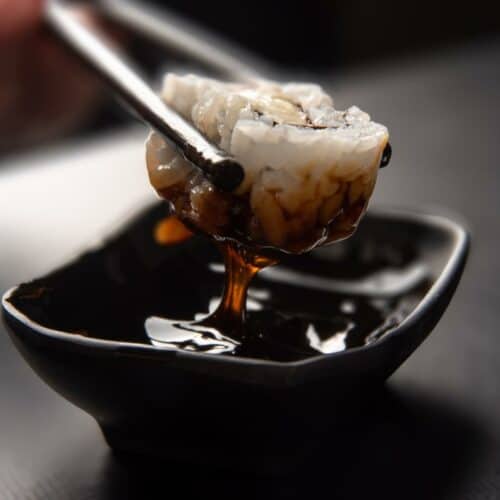
If you enjoy using dipping sauces and you enjoy Japanese food, tare sauce is for you! Tare sauce is a Japanese dipping sauce.
Therefore, it can be used to flavor any type of cuisine. People use it as a glaze, for dipping, as a soup base, or as a marinade.
However, it can also be used for grilling meals such as yakitori and yakiniku, where it can be used in place of teriyaki sauce. It has a similar brown color and slightly sweet taste.
Tare sauce is typically made with soy sauce, mirin, sake, brown sugar, rice wine vinegar, garlic, and grated ginger.
We have a recipe using dashi as well, for a deep umami flavour.
It is a versatile sauce that can be used in countless ways, but it tastes best when it’s paired with grilled meats.
Warishita sukiyaki sauce
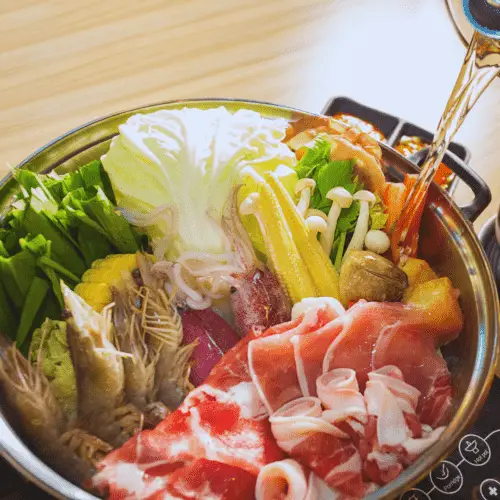
Sukiyaki is a classic Japanese comfort food dish that features thinly sliced meat, tofu, and fresh vegetables simmered in a savory broth.
It is usually prepared in a cast iron skillet or a clay pot over an open flame, and the sauce used to flavor this dish is called warishita.
The warishita sauce is made using 4 popular Japanese seasonings: mirin, sake, soy sauce and sugar.
The result is a rich and flavorful sauce that is delicious when drizzled over slices of beef, tofu, mushrooms, and fresh vegetables.
But it can also be used to flavor other types of hot pot dishes, even soups.
It adds a deep and umami flavor to your favorite dishes, while also adding some sweetness and acidity.
Nitsume “unagi” eel sauce

Nitsume is a sauce that is frequently used with sushi but is sometimes disregarded when making sushi at home; it may also be used with many other foods.
Because it is typically used to glaze fish, primarily eel (unagi in Japanese), therefore, you may not see it on your plate, but you can definitely taste it.
To make nitsume eel sauce, all you need to do is cook and reduce a liquid made up of mirin, soy sauce, and sugar.
You can use an aged soy sauce if you’re looking for a richer, more umami taste.
Homemade Mentsuyu Sauce
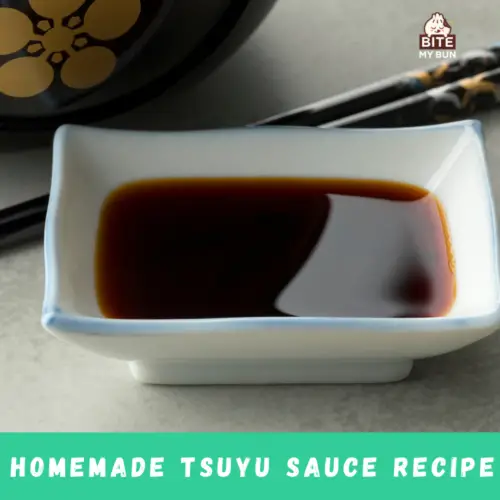
Mentsuyu sauce is a versatile Japanese condiment that can be used in many different ways.
It is typically made from a mixture of soy sauce, mirin, sake, and dashi broth (kombu and bonito flakes).
This rich and savory sauce is commonly used as a dipping sauce for noodles, a glaze for meat and seafood, or a seasoning for soups and stews.
Our delicious homemade Mentsuyu sauce recipe is easy to prepare and will add a ton of flavor to your Japanese-inspired dishes.
Simply combine the ingredients in a saucepan and simmer on low heat. Then you can serve it once it’s cooled!
Confused now? Here’s how Dashi compares to Tsuyu compares to Mirin compares to Miso…
Agedashi Tofu Recipe: Salty Umami Sauce With Fried Tofu
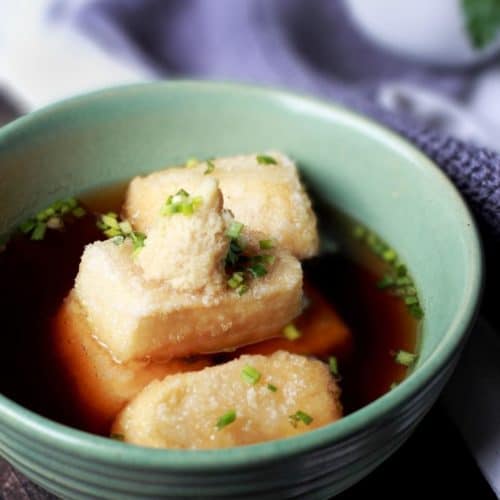
This recipe is for a traditional Japanese dish called Agedashi Tofu.
It is made with a rich, salty umami sauce that is poured over crispy fried tofu and enjoyed as an appetizer or snack.
The technique for making the tofu is pretty straightforward: gently simmer slices of firm tofu in a dashi broth until they are tender and golden.
The real star of the dish is the umami dashi and mirin sauce. It’s a mix of sweet and salty that complements the crispy tofu perfectly.
To make this dish, you want to use momen tofu and a flavorful dashi stock.
You can microwave the tofu to speed up the process, or you can pan-fry it if you prefer a crispy exterior.
Then simply pour over the dashi and mirin sauce, garnish with scallions and toasted sesame seeds, and serve!
Sesame Ginger Soy Sauce
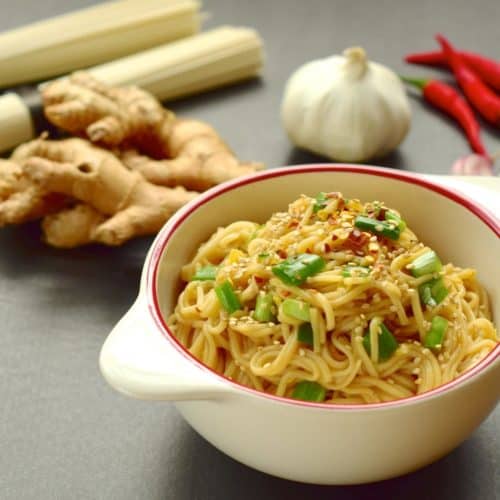
If you’re looking for a sauce with a bit of a spicy kick, you can try the famous Japanese sesame ginger soy sauce.
This quick and easy recipe is perfect to combine with just about any type of protein, from fish to chicken to tofu.
The sauce also tastes good drizzled over noodles or rice dishes.
To make this sauce, you’ll need a mix of sesame seeds, Kewpie mayo, soy sauce, mirin, vegetable oil, rice vinegar, honey, sesame oil, and some black pepper and fresh ginger.
This combination of ingredients creates the perfect balance of sweet and salty with just a hint of spiciness.
Easy Sushi Tonkatsu Sauce Recipe

An authentic tonkatsu sauce is a bit hard to make because you need to use fresh fruit purees and lemons, but if you’re in a hurry, our easy sushi tonkatsu sauce recipe is sure to hit the spot.
This versatile Japanese condiment is perfect for dipping fried foods or drizzling over your favorite sushi rolls or sides.
It’s a simple mixture of ketchup, Worcestershire sauce, soy sauce, brown sugar, mirin, garlic, and ginger.
You can even use this sauce as a meat marinade for Japanese BBQ or in your stir-fry!
Nikiri Sauce

If you are seeking a good condiment to impart a delicate flavor to Asian dishes, nikiri sauce may be the best option.
Nikiri is a thin glaze that is frequently applied to fish in Japanese cuisine prior to serving. Once served, soy sauce or any other condiment is unnecessary.
The nikiri is enough because it imparts a sweet and salty flavor reminiscent of teriyaki sauce.
Nikiri sauce is widely used on sushi, and is particularly tasty on sashimi.
To prepare the nikiri, you only need a few simple ingredients: sake, soy sauce, mirin, and dashi stock.
The key is to reduce these ingredients together until the mixture is thick enough to coat vegetables or fish in a light glaze.
Why add mirin to your sauces?
Mirin is the perfect addition to any sauce, marinade, glaze or dip because it adds a subtle sweetness and richness to any dish.
Mirin, which is a type of rice wine similar to sake, gives sauces and marinades an extra depth of flavor.
It also helps to balance out the other flavors in the sauce, making it taste more complex and balanced.
If you are looking for new ways to incorporate more Asian flavors into your cooking, consider adding mirin to your sauces and marinades.
Whether you are making a teriyaki sauce or a stir-fry glaze, the addition of mirin will take your dishes to the next level!

10 Best Mirin Sauce Recipes
Ingredients
- 1 cup dried bonito flakes (katsuobushi)
- 1 piece dried kelp (kombu)
- ½ cup cooking sake
- 1 cup soy sauce
- 1 cup mirin
Instructions
- Grab a saucepan and pour in the sake, mirin, and soy sauce. Then add in the dried bonito flakes and the piece of kelp.
- Bring everything to a boil. Turn down the heat to low and simmer for about 5 minutes.
- Turn off the heat and let your sauce cool down.
- Remove the piece of kelp and strain the mixture using a sieve.
FAQs
What are some common uses for mirin sauce?
Mirin sauce is commonly used as a marinade or glaze in many different types of Asian cuisine. It can also be added to stir-fry dishes and sauces or used to top rice and noodle dishes.
Some people also use mirin-based sauces as a condiment or dip for seafood, poultry, and meat dishes.
Whatever your cooking needs may be, mirin sauce is sure to add an extra layer of flavor and complexity to any dish.
Ask any Japanese chef and they will agree mirin is one of the 4 must Japanese seasonings:
Are there any other ingredients that can be added to mirin sauce?
Yes, many people like to add different herbs and spices to their mirin sauce to give it an extra layer of flavor. Common additions include ginger, garlic, scallions, chilis, and sesame seeds.
You can also experiment with different types of soy sauce or vinegar to create unique flavor variations.
What’s the most popular Japanese sauce with mirin?
One of the most popular Japanese sauces that contain mirin is teriyaki sauce.
This sweet and savory sauce is typically made by combining soy sauce, mirin, sake or rice wine, and sugar.
It’s a great choice for glazing meats, seafood, and vegetables before grilling or baking, and it is also popular for use in stir-fry dishes and on noodle bowls.
Why is mirin such an important ingredient in sauces?
Mirin is an important ingredient in sauces because of its unique combination of sweetness and savory flavor.
It helps to balance out the other flavors in the sauce, enhancing and deepening their flavor profile.
Additionally, mirin is rich in umami flavors that help to deepen savory sauces and add a more complex flavor profile.
Mirin can also help mask smellier ingredients, such as fish or meat, and is a great ingredient for adding an extra layer of flavor to vegetarian dishes.
Conclusion
Now that we’ve shared our top 10 mirin-based sauces and marinades, it’s time to get cooking!
Whether you love making Asian-inspired dishes or just want a new and delicious condiment to add to your next meal, these recipes are sure to please.
So what are you waiting for? Get out your wok and get cooking today!
Can’t find mirin in the shops? Here’s what you can use instead
Check out our new cookbook
Bitemybun's family recipes with complete meal planner and recipe guide.
Try it out for free with Kindle Unlimited:
Read for freeJoost Nusselder, the founder of Bite My Bun is a content marketer, dad and loves trying out new food with Japanese food at the heart of his passion, and together with his team he's been creating in-depth blog articles since 2016 to help loyal readers with recipes and cooking tips.
